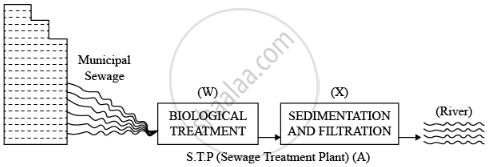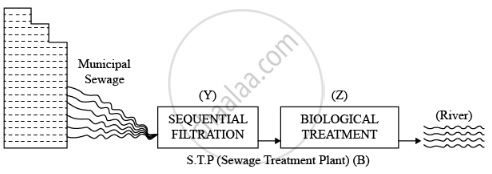Advertisements
Advertisements
Question
Three water samples namely river water, untreated sewage water and secondary effluent discharged from a sewage treatment plant were subjected to BOD test. The samples were labelled A, B and C; but the laboratory attendant did not note which was which. The BOD values of the three samples A, B and C were recorded as 20mg/L, 8mg/L and 400mg/L, respectively. Which sample of the water is most polluted? Can you assign the correct label to each assuming the river water is relatively clean?
Solution
Biological oxygen demand (BOD) is the method of determining the amount of oxygen required by micro-organisms to decompose the waste present in the water supply. If the quantity of organic waste in the water supply is high, then the number of decomposing bacteria present in the water will also be high. As a result, the BOD value will increase.
Therefore, it can be concluded that if the water supply is more polluted, then it will have a higher BOD value. Out of the above three samples, sample C is the most polluted since it has the maximum BOD value of 400 mg/L. After untreated sewage water, secondary effluent discharge from a sewage treatment plant is most polluted. Thus, sample A is secondary effluent discharge from a sewage treatment plant and has the BOD value of 20 mg/L, while sample B is river water and has the BOD value of 8 mg/L.
Hence, the correct label for each sample is:
| Label | BOD value | Sample |
| A | 20 mg/L | Secondary effluent discharge from a sewage treatment plant |
| B | 8 mg/L | River water |
| C | 400 mg/L | Untreated sewage water |
APPEARS IN
RELATED QUESTIONS
Explain the function of “anaerobic sludge digester” in a sewage treatment plant.
Distinguish between the roles of flocs and anaerobic sludge digesters in sewage treatments.
Explain the process of sewage water treatment before it can be discharged into natural water bodies.
What is sewage? In which way can sewage be harmful to us?
What is primary treatment of sewage?
Name the tank to which the sewage water is passed after the preliminary treatment?
Small part of activated sludge is passed back into ______ and major part is pumped into large tanks called ______.
______ refers to the organic matter which settles down after physical treatment of sewage.
Which of the following is put into Anaerobic sludge disaster for further sewage treatment?
Methanogenic bacteria are not found in ______.
Wastewater treatment generates a large quantity of sludge, which can be treated by ______.
The primary treatment of waste water involves the removal of ______.
Discuss about the major programs that the Ministry of Environment and Forests, Government of India, has initiated for saving major Indian rivers from pollution.
Ganga has recently been declared the national river. Discuss the implication with respect to pollution of this river.
In what way anaerobic sludge digestion is important in sewage treatments?
Study the given diagram of the Sewage Treatment Plant (S.T.P.) and answer the question that follows:


- Which one of the two 'S.T.P.' (A) or (B) will be more effective in treating the human excreta in municipal waste?
- Write the steps followed in carrying the treatment of the sewage in step (Z), once the BOD of sewage is reduced significantly till it is passed on to the "anaerobic sludge digesters".
After a significant reduction in the BOD of wastewater, it is passed into a settling tank where bacterial flocs are allowed to sediment. This sediment is called ______.
The aeration tank of a sewage treatment plant is not functioning properly. Explain in detail the impact of this on the treatment of sewage and BOD of the effluent.
